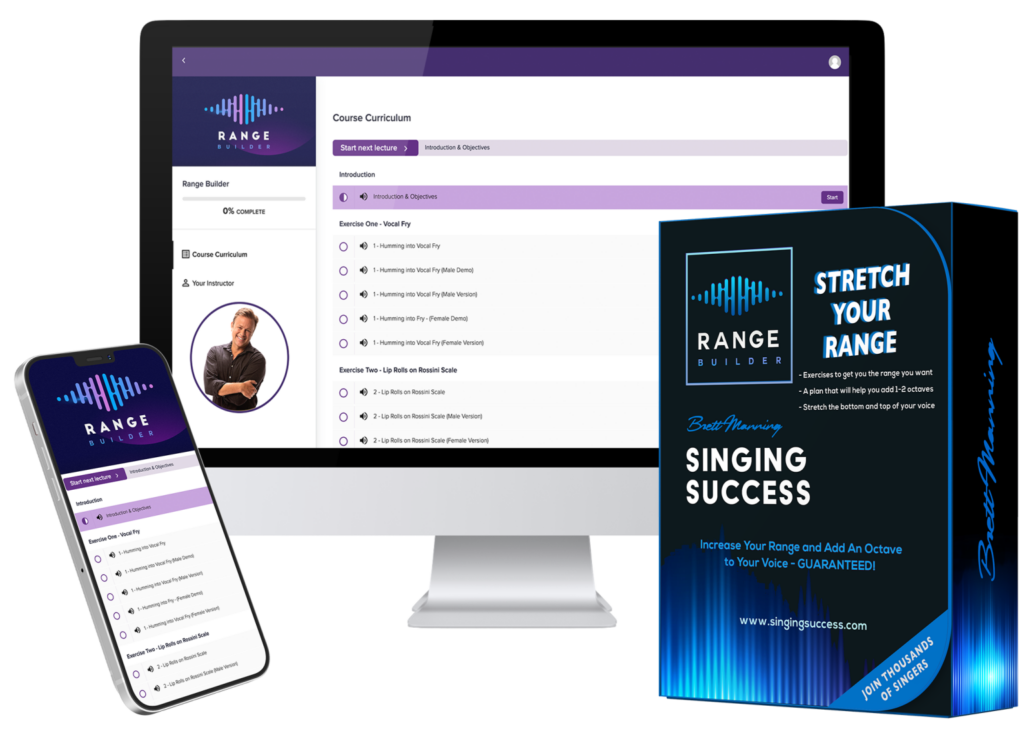There are six standard voice types. You’re probably familiar with them all, and you’ve probably heard them separated into two groups: Women tend to take Soprano, Mezzo-Soprano, and Alto (contralto), while men sing in the ranges of Tenor, Bariton, and Bass. There are many subcategories such as basso profundo and lyric coloratura soprano, but we won’t go into those details right now.
Today, we are going to dive into the bass voice. What is it like? What can a bass singer do? How do you care for it? And so on.
What Exactly is the Bass Voice Type?
Bass voices are easily recognized by rich, deep, and resonant tones. Typically, these voice types belong to males and they are the lowest of the voice types. A person’s speaking voice won’t always clue you into whether or not they sing low in the bass clef, but here are some key characteristics of a true bass singing voice:
- Low Pitch: Bass singers have the lowest vocal range compared to other male voice types (tenor, baritone). They can sing comfortably in the uniquely lower octaves of the musical scale marking them as powerhouses of the vocal world.
- Full and Rich: The bass voice has a robust quality, often described as velvety. The deep sounds that fall outside of the typical range often cause people to feel relaxed.
- Resonance: Bass singers usually experience strong resonance in their chest and throat, contributing to the warmth and depth of their sound. This has to do with the low tones creating wide, slow vibrations.
- Powerful Low Notes: This is apart from the low pitch. Many male voices can hit low notes, but it’s only the true basses that can hit and sustain the deepest notes with a certain kind of vocal weight, distinguishing them from the rest of the male voices.
- Vocal Timbre: Each bass voice has its unique timbre, with most being darker and more profound than the other voice types.

Add 1-2 Octaves to Your Voice
Safely Hit High Notes With Ease
What if, instead of worrying and tensing up every time you have to sing a “high” note in a song… you could sing them with ease? What if instead of being controlled by the notes on a scale, you control them?
Many singers think that they are bound by the limited range of their voice. But here’s a secret…If you can make the sound, you can sing it!
Here’s What you’ll get With Range Builder
- Effective exercises to get you the range you want
- A comprehensive training plan that will help you add 1-2 octaves
- A comprehensive approach to safely “stretch the bottom and top of your voice
- Explanations and glossary of commonly used singing terms
Brett Manning Demonstrates A 5 Octave Range!
Understanding Bass Vocal Range
It is important to understand the bass vocal range to properly appreciate the diverse world of music. The deep and sonorous quality of a bass voice grounds and stabilizes music compositions.
A bass singer’s ability to hit and sustain very low notes is awe-inspiring in a way that leaves a lasting impression on listeners. From classical music to contemporary, bass singers play crucial roles, creating foundations and adding depth to every musical arrangement they’re a part of.
The need to understand is about more than just the technical aspect. Understanding bass voice types gives you a deeper appreciation of the emotional expressiveness and artistry they can and do contribute to music. Operatic arias, Jazz, Blues… the bass voice resonates with each audience on profound – though different – levels, in a way that transcends language barriers.
Bass voices are a treasure trove of musical possibilities, enriching musical experiences with the way they seem to draw out emotions and place them within the listener’s reach.
How Can I Determine if I'm a Bass Singer?
- Range: Tessitura means your voice has the best and most natural sound quality in a particular range, usually excluding the very extreme edge of your range on either side. Bass voices have a specific range that we will discuss a little further down.
- Tone: A bass voice is generally characterized as having a rich and full timbre with deep rubbing qualities. Often, you can check to see if the lowest portion of your range opens up to your chest voice.
- Passagio: “Passagio” is otherwise known as your break range. This is where your voice transition from chest to head voice. Without proper training, your voice will crack and break when singing these notes, but transitioning smoothly can be learned. Base voices usually experience their passiagio around a C4 or a D4.
What is the Average Bass Range?
On average, the bass range is E2-E4. For reference, E4 is the first E above middle C. The human voice is incredibly unique to each person, which means vocal ranges are also unique. This measurement is only an expression of what is considered standard.
What is the Lowest Note a Bass Can Sing?
The average low end of a bass range is the E2 we just discussed. However, there are other categories of bass voices that can reach far lower.
The Schwarzer Bass, for example, refers to a type of bass voice known as “Basso Profondo.” In German, “Schwarzer” means “black,” and in this context, it describes the dark and resonant quality of this bass voice. This sub-category of basses is expected to reach at least a C2 without losing their strong sound.
Other, lower notes have been recorded but such instances are uncommon.
Is Bass A Rare Voice Type?
Yes, a true bass voice, particularly one with a deep and resonant Basso Profondo range, is relatively rare compared to other vocal types.
The rarity of true bass voices can be attributed to several factors:
- Genetics: A person’s vocal range and timbre are heavily influenced by their anatomical structure. Bass voices require a specific vocal cord length and thickness that not everyone is born with.
- Training and Technique: While certain genetics are required for a true bass voice, developing and maintaining strength and endurance cannot be achieved without dedicated training and specific vocal techniques. Many singers may sing within a bass range but lack the rich depth that a true bass provides because they don’t know how to nurture it.
- Demand in Music: The music industry has shifted to a world that often favors tenors and baritones. This is partially because those voices are much more common and they’re very versatile in terms of what style of music the vocalist is performing. As a result, there is less emphasis on cultivating and showcasing true bass voices.
How Many Octaves Can A Bass Sing?
Generally, basses cannot sing more than two octaves. The most comfortable range for basses is easy to remember as the bottom line of the bass clef to the top line.
Who Are Some of the Most Popular Bass Vocalists?
Bass singers span every genre. Here are some well-known artists you can look up for yourself:
- Barry White: Barry White was an American singer, songwriter, and composer known for his velvety voice and soulful ballads. He was a prominent figure in the soul and R&B music genres and is best known for hits like “Can’t Get Enough of Your Love, Babe” and “You’re the First, the Last, My Everything.”
- Johnny Cash: Johnny Cash, also known as the “Man in Black,” was an iconic American singer-songwriter and guitarist. He was a prominent figure in country music and also dabbled in rock and folk genres. His deep, distinctive bass-baritone voice and storytelling style made him one of the most influential musicians of the 20th century.
- Boris Christoff: Boris Christoff was a Bulgarian opera singer with a commanding bass voice. He was considered one of the greatest basses of the 20th century and performed in various opera houses worldwide, becoming particularly associated with roles like Boris Godunov and Don Giovanni.
- JD Sumner: JD Sumner was an American gospel singer. He was a key member of the gospel group The Stamps Quartet and also performed with Elvis Presley as a member of The Stamps Quartet and The Voice.
- Leonard Cohen: Leonard Cohen was a Canadian singer-songwriter, poet, and novelist. He was a bass-baritone voice and was known for his poetic and introspective songwriting. Some of his famous songs include “Suzanne” and “Hallelujah,” the latter, you might have heard featured in the movie, Shrek.
- Tim Storms: Tim Storms is an American singer with one of the lowest vocal ranges ever recorded. He holds the Guinness World Record for the lowest note sung by a human voice (a G-7!) and has performed with various vocal groups and ensembles.
- Josh Turner: Josh Turner is an American country singer and songwriter. He has released several successful country albums and is known for hits like “Long Black Train” and “Your Man.”
- Tay Zonday: Tay Zonday is an American singer, songwriter, and YouTube personality. He gained viral fame with his song “Chocolate Rain,” showcasing his deep voice and unique style.
- Avi Kaplan: Avi Kaplan is an American singer known for his time as the bass vocalist of the acapella group, Pentatonix. He has a memorable voice and is appreciated for his vocal range and control.
- Bob Bingham: Bob Bingham is an American opera singer. He has performed with various opera companies and is highly noted for his vocal talent and interpretations.
How Do You Improve Your Bass Voice?
Developing your bass voice is a gradual process that takes time and dedication. While you’re training, avoid pushing your voice beyond its limits and be patient. Be patient with yourself as you are building vocal strength and control because it doesn’t happen overnight.
Basses contribute so much to the musical landscape. Cultivating that voice type can be tricky, but it’s so important. The best way is to learn from someone else’s experience and years of training. However, if that isn’t possible, if you’re in a limbo stage between teachers, or anything else. here are ways you can understand and develop your voice on your own.
Understand Vocal Cords
Vocal cords, also known as vocal folds, are a pair of muscular bands located inside your voice box inside the throat. The vocal cords are crucial to producing sounds when you speak or sing. As a matter of fact, that’s their entire purpose.
When you speak or sing, air is pushed from the lungs, through the windpipe (trachea) and passes between the vocal cords. When they’re relaxed, the vocal cords remain open and allow air to flow freely through the larynx without causing vibrations, which is why you can breathe without making noise.
When you choose to produce sound, the vocal cords come together, narrowing the gap between them. As the air is pushed through that gap, the vocal cords vibrate and the vibrations produce sound. It’s the speed of the vibrations and the tension in the cords that determine what pitch you’re creating. Faster vibrations (higher tension) create higher-pitched sounds and slower vibrations (lower tension) create lower-pitched sounds.
The vibrations of the vocal cords produce a sound that resonates inside the vocal tract. The vocal tract includes the throat, mouth, nasal cavities, and the upper part of the esophagus. The size and shape of the vocal tract modify the sound, adding different tones and timbres to the voice before it escapes through your mouth.
The deep and more resonant quality associated with the bass voice is primarily a result of the longer, thicker vocal cords. The anatomical difference is what allows bass singers to produce slower vibrations and create those very low pitches that make them stand out.
It is important to understand that anatomic structure plays a significant role in singing. Proper training and technique should be emphasized when striving for a fully-developed, healthy voice.
Make Sure Your Jaw Is Dropped
Jaw tension is renowned for having negative effects on your vocal cords and overall vocal performance. When the jaw is tense, it restricts movement, limiting your range and your voice’s resonance. Jaw tension can cause a strained and/or forced aspect to your voice and can also cause vocal fatigue and damage.
To make sure your jaw is relaxed while singing, ensure the jaw is slightly dropped and the mouth open in a way that doesn’t cause excessive tension. Pay attention and consciously release any tightness you’re feeling during vocal exercises as well as performances. There are a lot of warm-up routines that include gentle jaw stretches and can be very beneficial for promoting jaw relaxation.
Relax Your Mouth
Your tongue and jaw are the primary sources of tension in your mouth.
In order to sing high notes, some tension is necessary. It’s important to have strategic, technically correct tension to reach and not just strain. However, tension has the opposite effect on low notes. It actually makes singing in the lower register much harder and should be avoided.
Pay Attention to Your Posture
Posture is never to be disregarded. Make sure that every time you sing, you are standing up straight with your shoulder blades slightly back and keep your head up and facing forward. Stooped posture can cause strain on your voice through tension on your vocal cords.
Instead of only using good posture when in a musical setting, try applying it to your everyday life. If good posture becomes a habit, it will be much easier to maintain when nerves or stress are involved with your performance. On top of that, it benefits the overall health of your body, not just your voice.
Don't Use Your Chest Voice
Instead of trying to belt with the full force of your chest voice when you’re in that lower register, put your energy into mouth formation. Loosen your jaw when possible and let the air flow out of your mouth as freely as you can. The less tension, the better.
This will probably be hard to do in the beginning because the singer’s natural tendency when notes get difficult is to tense up. We feel that we can force our voices to comply if we’re just commanding enough. While a strong voice is important, you’re working against yourself when you try to force out low notes through tension. Relaxation and gentle coaxing are your best bets.
Have The Microphone Close
Bass notes can be hard to project very far. A well-placed microphone can be a lifesaver in situations tricky situations. Make sure it’s close to your mouth and picking up every pit of your sound.
Obviously, we don’t want to rely on the microphone every day, but some venues and, let’s be honest, some notes need that extra boost. Never become complacent by expecting the microphone to do the work for you, but accept the help when necessary.
What Exercises Can I Do to Help Me Sing Lower?
It can be difficult to know where to start when it comes to learning how to sing lower notes. A lot of the typical warm-up exercises aren’t specifically geared toward extending the lower register. While those exercises are important for everyday vocal health, sometimes we need something a little more personalized. Here are a few basic exercises you can use to get started.
Do Vocals With Long Exhales
Begin every warm-up with a set of long sighs. There should be no pitch to these first sighs, just a relaxed, outward breath. After several of those, begin adding notes and sighing with a descent. Start at the highest note in your head voice and work down to the deepest bass note you can muster. Slide the pitches so that there are no defined steps.
Practice Descending Scales
Descending scales using solfege is always a good exercise. Go from sol to do (sol-fa-mi-re-do), moving the scale downward as you progress.
You can also try this with different vowel sounds and experiment with different keys.
Use Descending Arpeggios
An arpeggio is the equivalent of a broken-up cord formed with the first, third, and fifth scale degrees. In solfege, it would be do-mi-sol-do ascending and do-sol-mi-do descending. For your exercise, try starting your arpeggios on sol (the fifth scale degree) and work down to do. As with the scales, work the arpeggio downward, stretching your voice but not straining it.
Perfect Your Bass Vocals With Classes!
Fast-Track Your Success!!

VIP Membership includes:
- Exclusive Facebook Group
- Interact with our vocal coaches–ask them YOUR question
- Live warmups
- Masterclasses and Q&As with Brett Manning and his guests
- SS360 QuickStart Program
- SS360 – The FULL Systematic Vocal Course
- Vocal Hacks
- Range Builder
- Mastering Mix
- Mastering Harmony
- Mastering Vibrato
- Vocal Therapy
- Plus…exclusive content only found here all along the way!






